Stridulatory Organs and Sound Recognition of Three Species of Longhorn Beetles (Coleoptera: Cerambycidae)
Simple Summary
Abstract
1. Introduction
2. Materials and Methods
2.1. Insect Collection and Rearing
2.2. Sound Collection
2.3. Preprocessing and Analysis
2.4. Light Microscopy and SEM
2.5. Statistical Analysis
3. Results
3.1. Morphology of Stridulatory Organs
3.2. Sound Analysis
3.3. Sound Recognition
4. Discussion
Author Contributions
Funding
Data Availability Statement
Acknowledgments
Conflicts of Interest
References
- Venkatesh, P.; Manisha, B.L.; Singh, S.K.; Mishra, V.K. Communication in insects: A review. J. Exp. Zool. 2023, 26, 1317–1327. [Google Scholar]
- Han, Q.; Hansson, B.S.; Anton, S. Interactions of mechanical stimuli and sex pheromone information in antennal lobe neurons of a male moth, Spodoptera littoralis. J. Comp. Physiol. A. 2005, 191, 521–528. [Google Scholar] [CrossRef] [PubMed]
- Kannan, K.; Galizia, C.G.; Nouvian, M. Olfactory strategies in the defensive behaviour of insects. Insects 2022, 13, 470. [Google Scholar] [CrossRef] [PubMed]
- Scheiner, R.; Abramson, C.I.; Brodschneider, R.; Crailsheim, W.; Farina, W.M. Standard methods for behavioural studies of Apis mellifera. J. Apicult. Res. 2013, 52, 1–58. [Google Scholar] [CrossRef]
- Cocroft, R.B.; Rodríguez, R.L. The behavioral ecology of insect vibrational communication. Bioscience 2005, 55, 323–334. [Google Scholar] [CrossRef]
- Low, M.L.; Naranjo, M.; Yack, J.E. Survival sounds in insects: Diversity, function, and evolution. Front. Ecol. Evol. 2021, 9, 641–740. [Google Scholar] [CrossRef]
- Zhang, Q.K.; Wu, S.Y.; Xing, Z.L.; Wang, H.H.; Lei, Z.R. Substrate-borne vibrational signals and stridulatory organs for sexual communication in leafminer, Liriomyza sativae (Diptera: Agromyzidae). Insect Sci. 2023, 30, 221–231. [Google Scholar] [CrossRef]
- Luo, C.Q.; Wei, C. Intraspecific sexual mimicry for finding females in a cicada: Males produce ‘female sounds’ to gain reproductive benefit. Anim. Behav. 2015, 102, 69–76. [Google Scholar] [CrossRef]
- Hou, Z.; Wei, S.; Wei, C. The best of both worlds: Cicada males change costly signals to achieve mates while females choose a mate based on both calling and courtship songs. Curr. Zool. 2022, 68, 716–725. [Google Scholar] [CrossRef]
- Schöneich, S. Neuroethology of acoustic communication in field crickets-from signal generation to song recognition in an insect brain. Prog. Neurobiol. 2020, 194, 101882. [Google Scholar] [CrossRef]
- Liu, Z.D.; Wickham, J.D.; Sun, J.H. Fighting and aggressive sound determines larger male to win male-male competition in a bark beetle. Insect Sci. 2021, 28, 203–214. [Google Scholar] [CrossRef] [PubMed]
- Davranoglou, L.R.; Mortimer, B.; Taylor, G.K.; Malenovský, I. On the morphology and evolution of cicadomorphan tymbal organs. Arthropod Struct. Dev. 2020, 55, 100918. [Google Scholar] [CrossRef] [PubMed]
- Song, H.; Béthoux, O.; Shin, S.; Donath, A.; Letsch, H.; Liu, S.; McKenna, D.D.; Meng, G.; Misof, B.; Podsiadlowski, L.; et al. Phylogenomic analysis sheds light on the evolutionary pathways towards acoustic communication in Orthoptera. Nat. Commun. 2020, 11, 4939. [Google Scholar] [CrossRef]
- Davranoglou, L.R.; Taylor, G.K.; Mortimer, B. Sexual selection and predation drive the repeated evolution of stridulation in Heteroptera and other arthropods. Biol. Rev. 2023, 98, 942–981. [Google Scholar] [CrossRef]
- Rosi-Denadai, C.A.; Scallion, M.L.; Merrett, C.G.; Yack, J.E. Vocalization in caterpillars: A novel sound-producing mechanism for insects. J. Exp. Biol. 2018, 221, jeb169466. [Google Scholar] [CrossRef]
- Quiroga, N.; Muñoz, M.I.; Pérez-Espinoza, S.A.; Penna, M.; Botto-Mahan, C. Stridulation in the wild kissing bug Mepraia spinolai: Description of the stridulatory organ and vibratory disturbance signal. Bioacoustics 2020, 29, 266–279. [Google Scholar] [CrossRef]
- Miller, P.L. A note on stridulation in some cerambycid beetles and its possible relation to ventilation. Physiol. Entomol. 1971, 46, 63–68. [Google Scholar] [CrossRef]
- Li, L.; Sun, F.; Hu, J.H.; Yin, Y.; Chi, D.F. Ultrastructure of stridulating organ of Xylotrechus rusticus L. (Coleoptera, Cerambycidae) and behavioral responses to alarm sounds. J. For. Res. 2013, 24, 547–552. [Google Scholar] [CrossRef]
- Römer, H. Insect acoustic communication: The role of transmission channel and the sensory system and brain of receivers. Funct. Ecol. 2020, 34, 310–321. [Google Scholar] [CrossRef]
- Escola, J.P.L.; Guido, R.C.; da Silva, I.N.; Cardoso, A.M.; Maccagnan, D.H.B.; Dezotti, A.K. Automated acoustic detection of a cicadid pest in coffee plantations. Comput. Electron. Agric. 2020, 169, 105215. [Google Scholar] [CrossRef]
- Fleurat-Lessard, F.; Tomasini, B.; Kostine, L.; Fuzeau, B. Acoustic detection and automatic identification of insect stages activity in grain bulks by noise spectra processing through classification algorithms. In Proceedings of the 9th International Working Conference on Stored Product Protection, Sao Paulo, Brazil, 15–18 October 2006; pp. 476–486. [Google Scholar]
- Njoroge, A.W.; Mankin, R.W.; Smith, B.W.; Baributsa, D. Effects of hermetic storage on adult Sitophilus oryzae L. (Coleoptera: Curculionidae) acoustic activity patterns and mortality. J. Econ. Entomol. 2017, 110, 2707–2715. [Google Scholar] [CrossRef] [PubMed]
- Towsey, M.; Wimmer, J.; Williamson, I.; Roe, P. The use of acoustic indices to determine avian species richness in audio-recordings of the environment. Ecol. Inform. 2014, 21, 110–119. [Google Scholar] [CrossRef]
- Kawakita, S.; Ichikawa, K. Automated classification of bees and hornet using acoustic analysis of their flight sounds. Apidologie 2019, 50, 71–79. [Google Scholar] [CrossRef]
- Wang, Z.; Sun, Y.; Wang, J.; Wang, Y. Evaluation of Semanotus bifasciatus (Motschulsky) infestation in Platycladus orientalis plants using E-nose and GC-MS. Trans. ASABE 2020, 63, 1629–1637. [Google Scholar] [CrossRef]
- Rossa, R.; Goczał, J. Global diversity and distribution of longhorn beetles (Coleoptera: Cerambycidae). Eur. Zool. J. 2021, 88, 289–302. [Google Scholar] [CrossRef]
- Mankin, R.W.; Smith, M.T.; Tropp, J.M.; Atkinson, E.B.; Jong, D.Y. Detection of Anoplophora glabripennis (Coleoptera: Cerambycidae) larvae in different host trees and tissues by automated analyses of sound-impulse frequency and temporal patterns. J. Econ. Entomol. 2008, 101, 838–849. [Google Scholar] [CrossRef]
- Sutin, A.; Yakubovskiy, A.; Salloum, H.R.; Flynn, T.J.; Sedunov, N.; Nadel, H. Towards an automated acoustic detection algorithm for wood-boring beetle larvae (Coleoptera: Cerambycidae and Buprestidae). J. Econo. Entomol. 2019, 112, 1327–1336. [Google Scholar] [CrossRef]
- Wessel, A. Stridulation in the Coleoptera–an overview. In Insect Sounds and Communication. Physiology, Behaviour, Ecology and Evolution; Drosopoulos, S., Claridge, M.F., Eds.; CRC Press: Boca Raton, FL, USA, 2006; pp. 397–403. [Google Scholar]
- Cheng, J.Q. Sounds and behaviors of the thorax of adult longhorn beetles (Coleoptera: Cerambycidae). J. For. Sci. 1991, 27, 234–237. [Google Scholar]
- Noda, J.J.; Travieso-González, C.M.; Sánchez-Rodríguez, D.; Alonso-Hernández, J.B. Acoustic classification of singing insects based on MFCC/LFCC fusion. Appl. Sci. 2019, 9, 4097. [Google Scholar] [CrossRef]
- Pisner, D.A.; Schnyer, D.M. Support vector machine. In Machine Learning; Springer: Berlin/Heidelberg, Germany, 2020; pp. 101–121. [Google Scholar]
- Haskell, P.T. Sound production. In The Physiology of Insecta; Rockstein, M., Ed.; Academic Press: New York, NY, USA, 1974; pp. 353–410. [Google Scholar]
- Aiken, R.B. Sound production by aquatic insects. Biol. Rev. 1985, 60, 163–211. [Google Scholar] [CrossRef]
- Dong, X.M.; Jiang, L. Species-specific larval acoustic behaviour of three stag beetles (Coleoptera: Lucanidae), with emphasis on their stridulatory organs and acoustic signals. Arthropod Struct. Dev. 2023, 80, 101300. [Google Scholar] [CrossRef] [PubMed]
- Li, L.; Sun, F.; Ma, Y.K. Observations of stridulatory field fine structure in 6 species of Lamiinae beetles. J. For. Environ. 2019, 39, 220–224. [Google Scholar]
- Luo, C.Q.; Huang, S.H. Stridulatory sound production and acoustic signals of the longhorn beetle Batocera lineolata (Coleoptera: Cerambycidae). Bioacoustics 2021, 31, 148–159. [Google Scholar] [CrossRef]
- Gomes, L.; Solé, M.; Sousa-Lima, R.S.; Baumgarten, J.E. Influence of anthropogenic sounds on insect, anuran and bird acoustic signals: A meta-analysis. Front. Ecol. Evol. 2022, 10, 827440. [Google Scholar] [CrossRef]
- Folliot, A.; Haupert, S.; Ducrettet, M.; Sèbe, F.; Sueur, J. Using acoustics and artificial intelligence to monitor pollination by insects and tree use by woodpeckers. Sci. Total Environ. 2022, 838, 155883. [Google Scholar] [CrossRef]
- Mankin, R.; Hagstrum, D.; Guo, M.; Eliopoulos, P.; Njoroge, A. Automated applications of acoustics for stored product insect detection, monitoring, and management. Insects 2021, 12, 259. [Google Scholar] [CrossRef] [PubMed]
- Ali, M.A.; Dhanaraj, R.K.; Nayyar, A. A high performance-oriented AI-enabled IoT-based pest detection system using sound analytics in large agricultural field. Micro. Microsy. 2023, 103, 104946. [Google Scholar] [CrossRef]
- Maruthadurai, R.; Veerakumar, T.; Veershetty, C.; Chakaravarthi, A.S. Acoustic detection of stem and root borer Neoplocaederus ferrugineus (Coleoptera: Cerambycidae) in cashew. J. Asia-Pac. Entomol. 2022, 25, 101968. [Google Scholar] [CrossRef]
- Mankin, R.W.; Burman, H.; Menocal, O.; Carrillo, D. Acoustic detection of Mallodon dasystomus (Coleoptera: Cerambycidae) in Persea americana (Laurales: Lauraceae) branch stumps. Fla. Entomol. 2018, 101, 321–323. [Google Scholar] [CrossRef]
- Bedoya, C.L.; Brockerhoff, E.G.; Hayes, M.; Pawson, S.M.; Najar-Rodriguez, A.; Nelson, X.J. Acoustic communication of the red-haired bark beetle Hylurgus ligniperda. Physiol. Entomol. 2019, 44, 252–265. [Google Scholar] [CrossRef]
- Ribeiro, A.P.; da Silva, N.F.F.; Mesquita, F.N.; Araújo, P.D.C.S.; Rosa, T.C.; Mesquita-Neto, J.N. Machine learning approach for automatic recognition of tomato-pollinating bees based on their buzzing-sounds. PLoS Comput. Biol. 2021, 17, e1009426. [Google Scholar] [CrossRef] [PubMed]
- Phan, T.T.H.; Nguyen-Doan, D.; Nguyen-Huu, D.; Nguyen-Van, H.; Pham-Hong, T. Investigation on new Mel frequency cepstral coefficients features and hyper-parameters tuning technique for bee sound recognition. Soft Comput. 2023, 27, 5873–5892. [Google Scholar] [CrossRef]
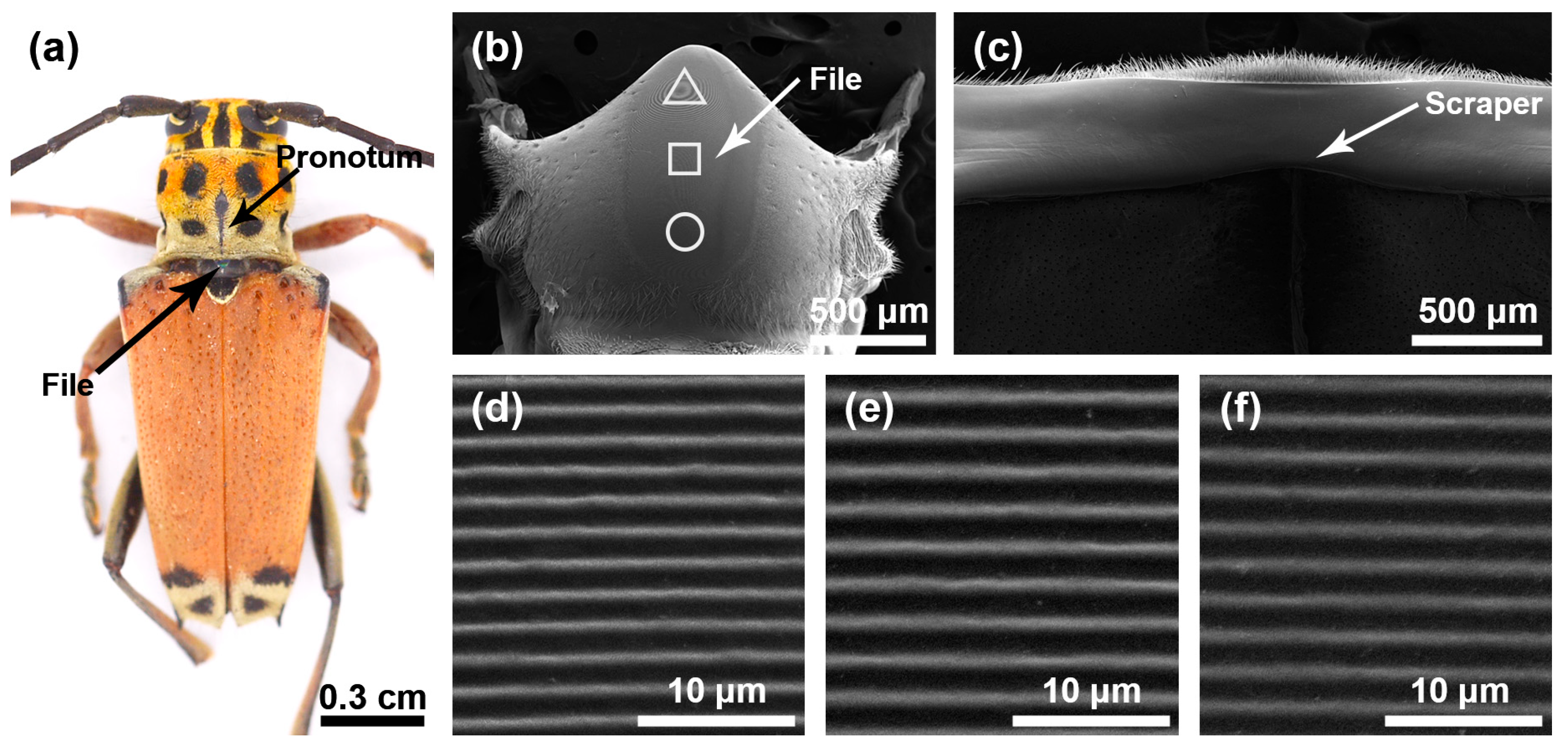
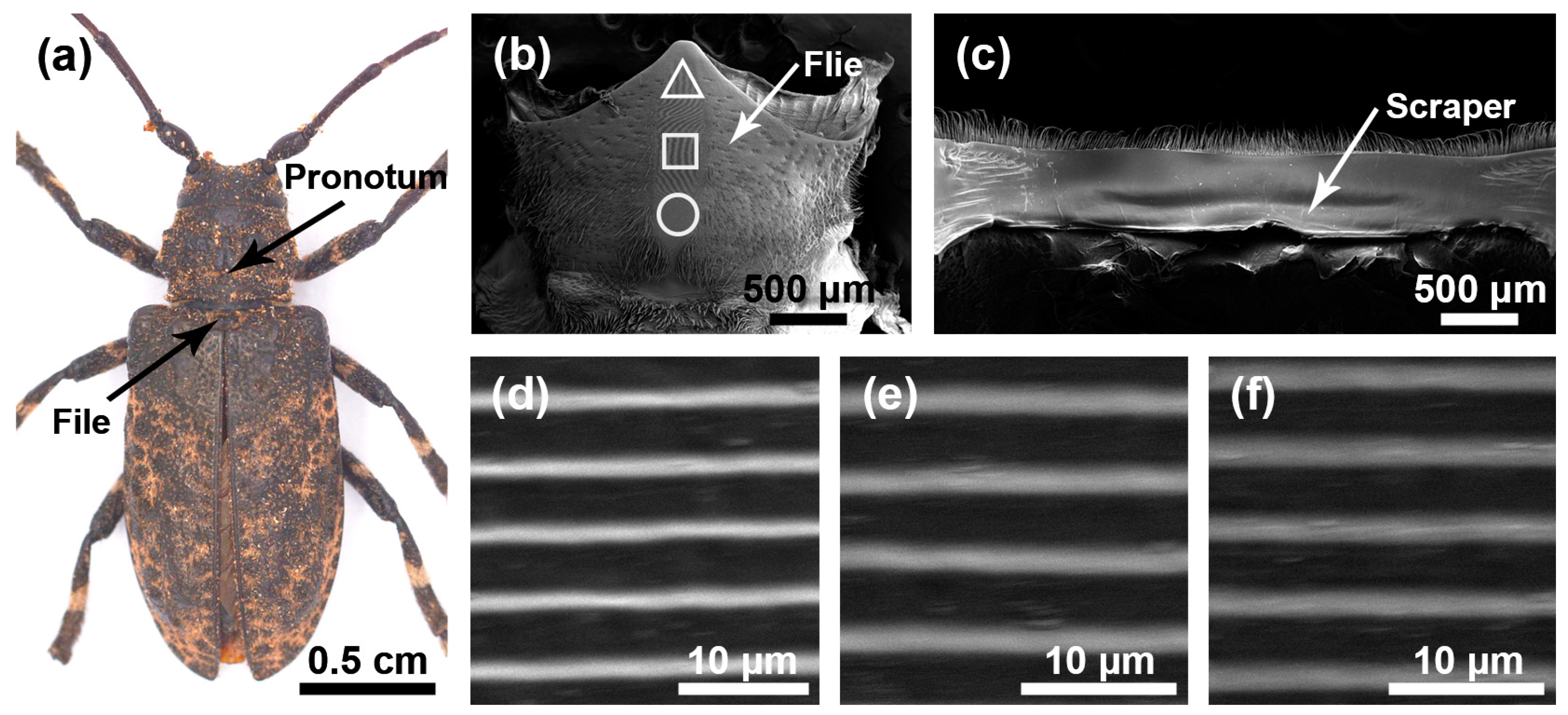
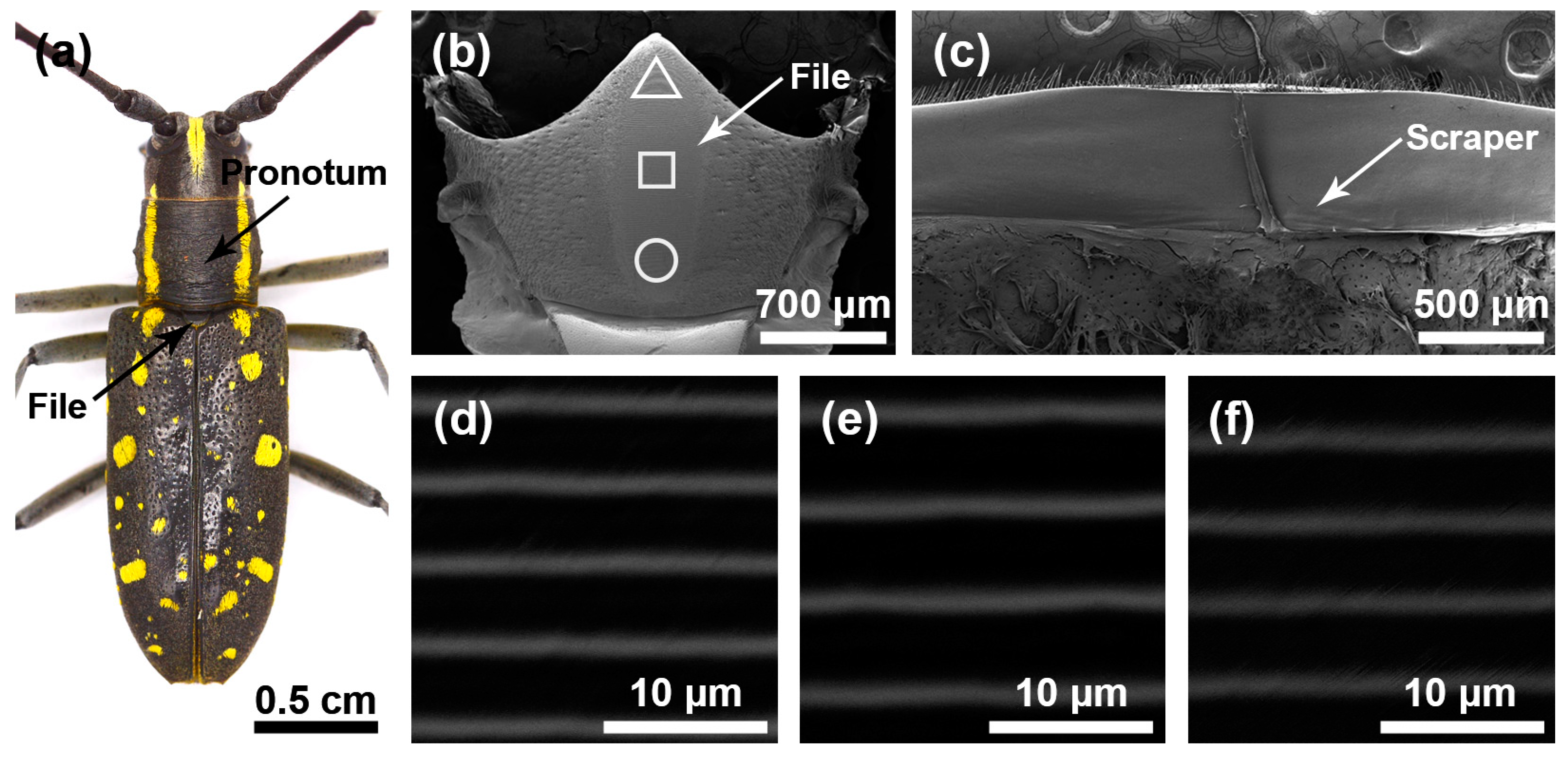
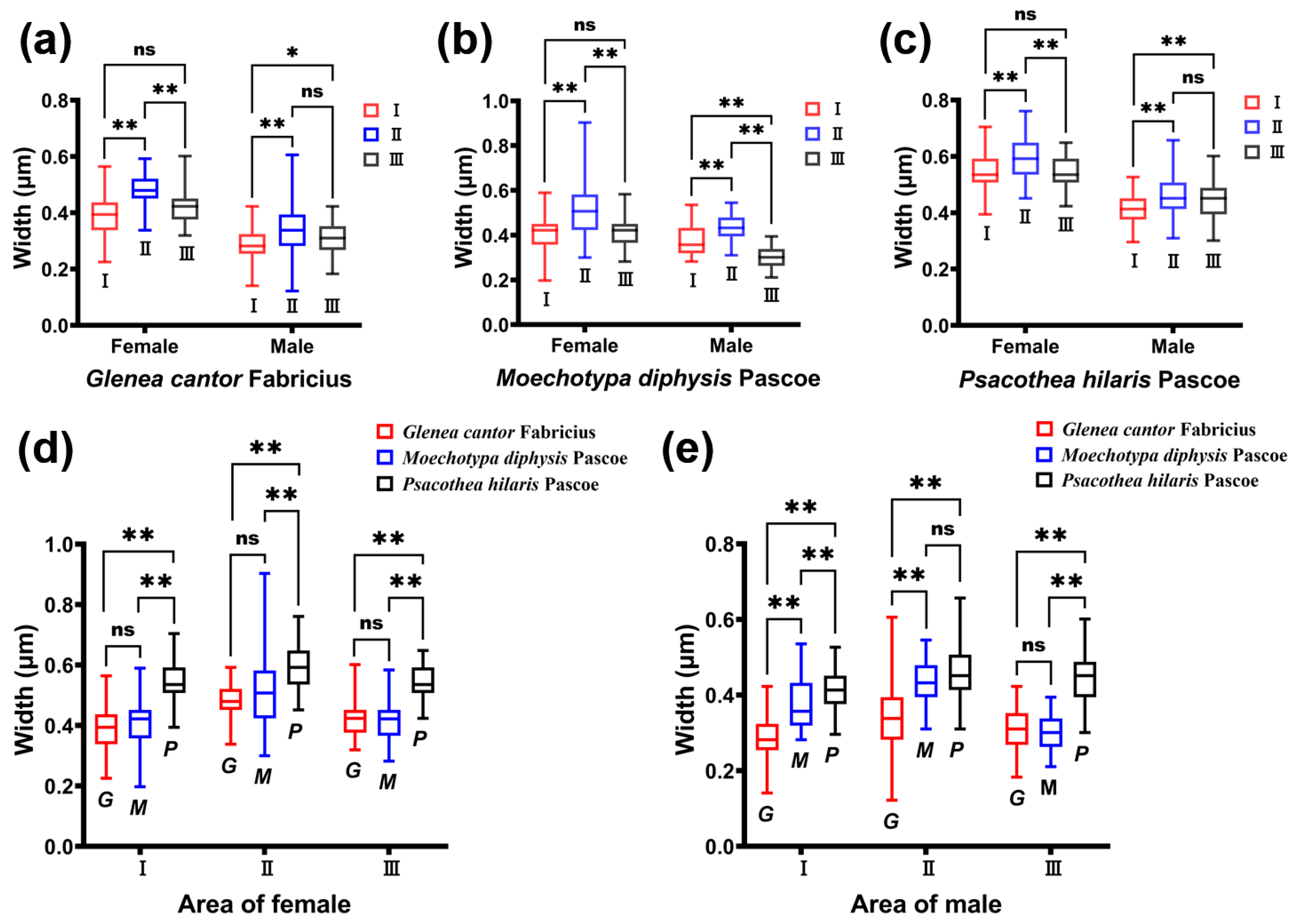
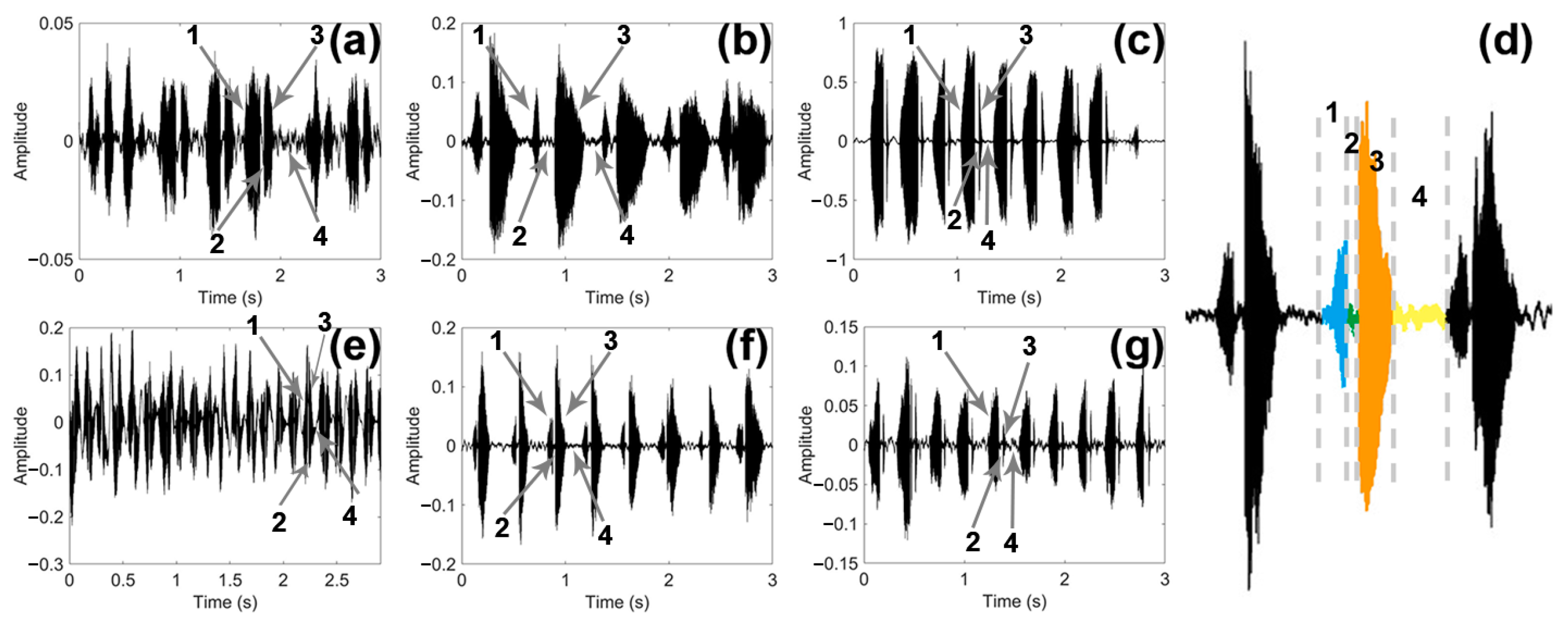
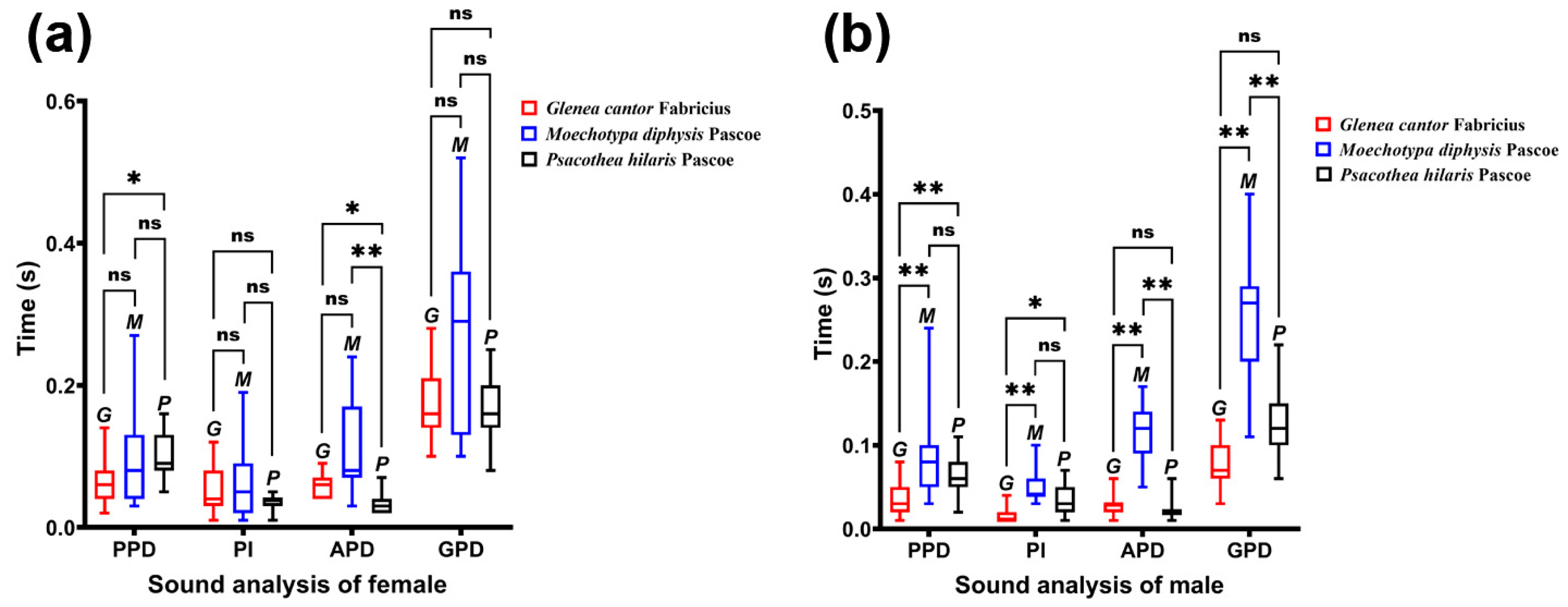

| Species | Area | Width (μm) Mean ± SD | Width (μm) Mean ± SD | z | p |
|---|---|---|---|---|---|
| ♀ | ♂ | ||||
| Glenea cantor | I | 0.387 ± 0.071 ** | 0.281 ± 0.056 | −8.047 | p < 0.01 |
| II | 0.481 ± 0.056 ** | 0.341 ± 0.105 | −8.267 | p < 0.001 | |
| III | 0.423 ± 0.059 ** | 0.315 ± 0.056 | −8.595 | p < 0.001 | |
| Moechotypa diphysis | I | 0.402 ± 0.081 ** | 0.377 ± 0.067 | −2.600 | p = 0.009 |
| II | 0.507 ± 0.128 ** | 0.430 ± 0.057 | −4.355 | p < 0.01 | |
| III | 0.417 ± 0.066 ** | 0.299 ± 0.039 | −9.194 | p < 0.001 | |
| Psacothea hilaris | I | 0.551 ± 0.074 ** | 0.413 ± 0.052 | −9.305 | p < 0.001 |
| II | 0.596 ± 0.070 ** | 0.462 ± 0.071 | −8.612 | p < 0.001 | |
| III | 0.538 ± 0.053 ** | 0.444 ± 0.066 | −7.808 | p < 0.01 |
| Species | Time | Time(s) Mean ± SD | z | p | |
|---|---|---|---|---|---|
| ♀ | ♂ | ||||
| Glenea cantor | PPD | 0.067 ± 0.031 ** | 0.034 ± 0.017 | −3.339 | p < 0.01 |
| PI | 0.049 ± 0.032 ** | 0.017 ± 0.010 | −3.364 | p < 0.01 | |
| APD | 0.059 ± 0.016 ** | 0.027 ± 0.013 | −4.212 | p < 0.01 | |
| PGD | 0.177 ± 0.055 ** | 0.078 ± 0.029 | −4.349 | p < 0.01 | |
| Moechotypa diphysis | PPD | 0.095 ± 0.070 | 0.085 ± 0.050 | −0.062 | p = 0.950 |
| PI | 0.060 ± 0.051 | 0.049 ± 0.018 | −0.293 | p = 0.770 | |
| APD | 0.110 ± 0.065 | 0.120 ± 0.035 | −1.021 | p = 0.307 | |
| PGD | 0.265 ± 0.133 | 0.254 ± 0.067 | −0.416 | p = 0.678 | |
| Psacothea hilaris | PPD | 0.099 ± 0.029 ** | 0.065 ± 0.026 | −2.940 | p = 0.003 |
| PI | 0.035 ± 0.011 | 0.036 ± 0.017 | −0.021 | p = 0.983 | |
| APD | 0.033 ± 0.015 * | 0.025 ± 0.013 | −2.308 | p = 0.021 | |
| PGD | 0.167 ± 0.043 * | 0.125 ± 0.041 | −2.519 | p = 0.012 | |
Disclaimer/Publisher’s Note: The statements, opinions and data contained in all publications are solely those of the individual author(s) and contributor(s) and not of MDPI and/or the editor(s). MDPI and/or the editor(s) disclaim responsibility for any injury to people or property resulting from any ideas, methods, instructions or products referred to in the content. |
© 2024 by the authors. Licensee MDPI, Basel, Switzerland. This article is an open access article distributed under the terms and conditions of the Creative Commons Attribution (CC BY) license (https://creativecommons.org/licenses/by/4.0/).
Share and Cite
Wei, J.-Q.; Wang, X.-Y.; Zheng, X.-L.; Tong, X. Stridulatory Organs and Sound Recognition of Three Species of Longhorn Beetles (Coleoptera: Cerambycidae). Insects 2024, 15, 849. https://doi.org/10.3390/insects15110849
Wei J-Q, Wang X-Y, Zheng X-L, Tong X. Stridulatory Organs and Sound Recognition of Three Species of Longhorn Beetles (Coleoptera: Cerambycidae). Insects. 2024; 15(11):849. https://doi.org/10.3390/insects15110849
Chicago/Turabian StyleWei, Jia-Quan, Xiao-Yun Wang, Xia-Lin Zheng, and Xin Tong. 2024. "Stridulatory Organs and Sound Recognition of Three Species of Longhorn Beetles (Coleoptera: Cerambycidae)" Insects 15, no. 11: 849. https://doi.org/10.3390/insects15110849
APA StyleWei, J.-Q., Wang, X.-Y., Zheng, X.-L., & Tong, X. (2024). Stridulatory Organs and Sound Recognition of Three Species of Longhorn Beetles (Coleoptera: Cerambycidae). Insects, 15(11), 849. https://doi.org/10.3390/insects15110849







